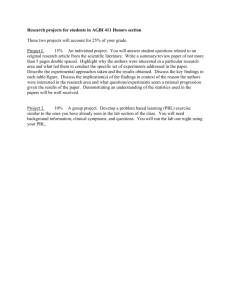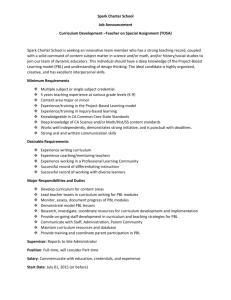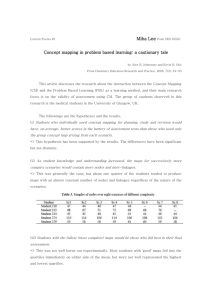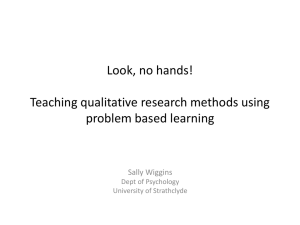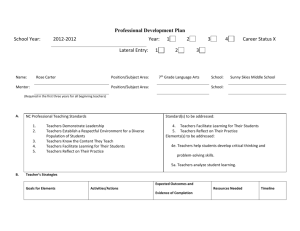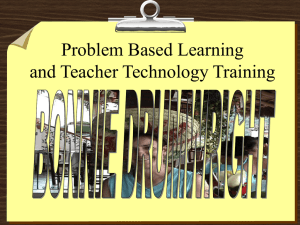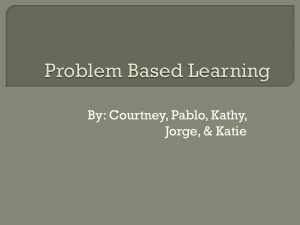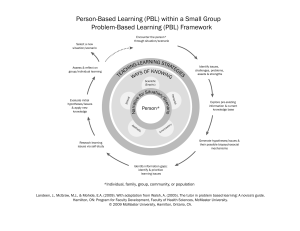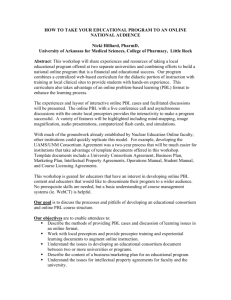FILA-MMS Chart in Chemistry PBL Lesson
advertisement
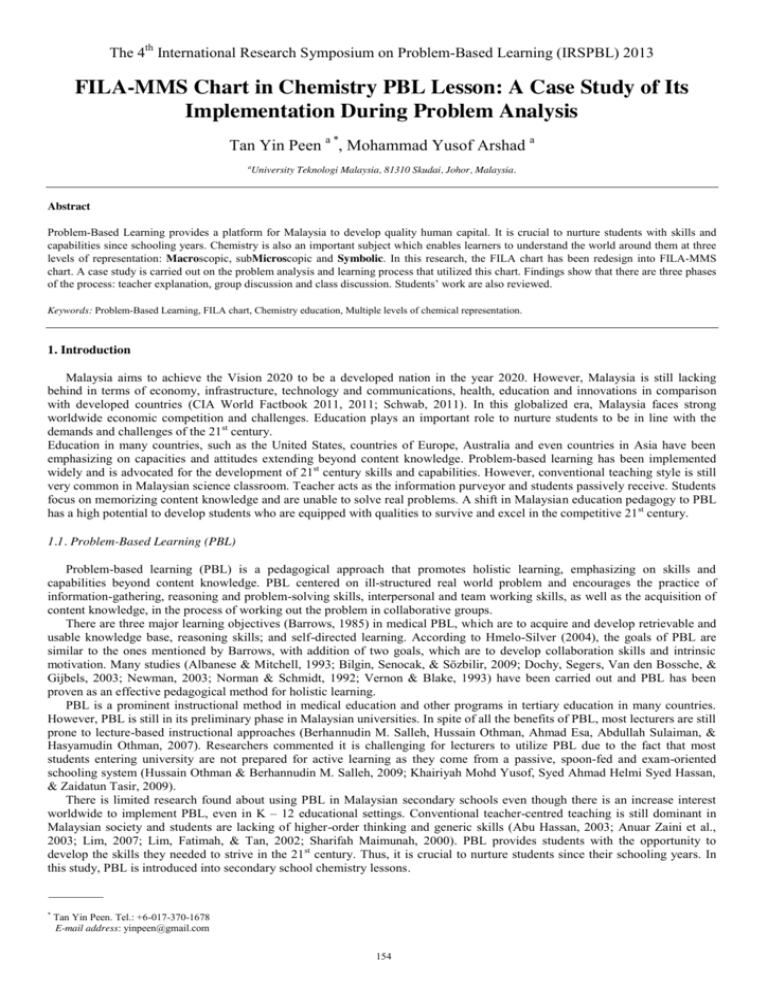
The 4th International Research Symposium on Problem-Based Learning (IRSPBL) 2013 FILA-MMS Chart in Chemistry PBL Lesson: A Case Study of Its Implementation During Problem Analysis Tan Yin Peen a *, Mohammad Yusof Arshad a a University Teknologi Malaysia, 81310 Skudai, Johor, Malaysia. Abstract Problem-Based Learning provides a platform for Malaysia to develop quality human capital. It is crucial to nurture students with skills and capabilities since schooling years. Chemistry is also an important subject which enables learners to understand the world around them at three levels of representation: Macroscopic, subMicroscopic and Symbolic. In this research, the FILA chart has been redesign into FILA-MMS chart. A case study is carried out on the problem analysis and learning process that utilized this chart. Findings show that there are three phases of the process: teacher explanation, group discussion and class discussion. Students’ work are also reviewed. Keywords: Problem-Based Learning, FILA chart, Chemistry education, Multiple levels of chemical representation. 1. Introduction Malaysia aims to achieve the Vision 2020 to be a developed nation in the year 2020. However, Malaysia is still lacking behind in terms of economy, infrastructure, technology and communications, health, education and innovations in comparison with developed countries (CIA World Factbook 2011, 2011; Schwab, 2011). In this globalized era, Malaysia faces strong worldwide economic competition and challenges. Education plays an important role to nurture students to be in line with the demands and challenges of the 21st century. Education in many countries, such as the United States, countries of Europe, Australia and even countries in Asia have been emphasizing on capacities and attitudes extending beyond content knowledge. Problem-based learning has been implemented widely and is advocated for the development of 21st century skills and capabilities. However, conventional teaching style is still very common in Malaysian science classroom. Teacher acts as the information purveyor and students passively receive. Students focus on memorizing content knowledge and are unable to solve real problems. A shift in Malaysian education pedagogy to PBL has a high potential to develop students who are equipped with qualities to survive and excel in the competitive 21 st century. 1.1. Problem-Based Learning (PBL) Problem-based learning (PBL) is a pedagogical approach that promotes holistic learning, emphasizing on skills and capabilities beyond content knowledge. PBL centered on ill-structured real world problem and encourages the practice of information-gathering, reasoning and problem-solving skills, interpersonal and team working skills, as well as the acquisition of content knowledge, in the process of working out the problem in collaborative groups. There are three major learning objectives (Barrows, 1985) in medical PBL, which are to acquire and develop retrievable and usable knowledge base, reasoning skills; and self-directed learning. According to Hmelo-Silver (2004), the goals of PBL are similar to the ones mentioned by Barrows, with addition of two goals, which are to develop collaboration skills and intrinsic motivation. Many studies (Albanese & Mitchell, 1993; Bilgin, Senocak, & Sözbilir, 2009; Dochy, Segers, Van den Bossche, & Gijbels, 2003; Newman, 2003; Norman & Schmidt, 1992; Vernon & Blake, 1993) have been carried out and PBL has been proven as an effective pedagogical method for holistic learning. PBL is a prominent instructional method in medical education and other programs in tertiary education in many countries. However, PBL is still in its preliminary phase in Malaysian universities. In spite of all the benefits of PBL, most lecturers are still prone to lecture-based instructional approaches (Berhannudin M. Salleh, Hussain Othman, Ahmad Esa, Abdullah Sulaiman, & Hasyamudin Othman, 2007). Researchers commented it is challenging for lecturers to utilize PBL due to the fact that most students entering university are not prepared for active learning as they come from a passive, spoon-fed and exam-oriented schooling system (Hussain Othman & Berhannudin M. Salleh, 2009; Khairiyah Mohd Yusof, Syed Ahmad Helmi Syed Hassan, & Zaidatun Tasir, 2009). There is limited research found about using PBL in Malaysian secondary schools even though there is an increase interest worldwide to implement PBL, even in K – 12 educational settings. Conventional teacher-centred teaching is still dominant in Malaysian society and students are lacking of higher-order thinking and generic skills (Abu Hassan, 2003; Anuar Zaini et al., 2003; Lim, 2007; Lim, Fatimah, & Tan, 2002; Sharifah Maimunah, 2000). PBL provides students with the opportunity to develop the skills they needed to strive in the 21 st century. Thus, it is crucial to nurture students since their schooling years. In this study, PBL is introduced into secondary school chemistry lessons. * Tan Yin Peen. Tel.: +6-017-370-1678 E-mail address: yinpeen@gmail.com 1.2. Multiple Levels of Chemical Representation Chemistry is an important subject. Our everyday life involves chemicals, reactions and phenomena related to chemistry. Learning and understanding chemistry aids our understanding of the world we live in. Chemical phenomena can be described at multiple levels of representation which are interconnected and related in terms of information. There are three levels of chemical representations, namely the macroscopic, submicroscopic and symbolic levels (Gilbert & Treagust, 2009; Chandrasegaran, Treagust, & Mocerino, 2007; Treagust, Chittleborough, & Mamiala, 2003; Johnstone, 1991). The abilities in making sense of concepts at each level and transferring knowledge between the three levels are essential towards developing a better understanding of chemical phenomena and the underlying chemistry concepts (Kern, et al., 2010; Treagust, et al., 2003). The macroscopic level of representation is the perceptible properties or phenomena encountered in daily experiences or laboratory experiments (Gkitzia, Salta, & Tzougraki, 2011; Gilbert & Treagust, 2009; Treagust, et al., 2003). For example, changes in state, changes in color, temperature and pH, decomposition of reactants and formation of products in chemical reactions. The macroscopic phenomena can either be of one’s direct experiences or from secondary sources, such as videos or pictures. At the submicroscopic level, matter is represented as its constituent particles (e.g. atoms, molecules, electrons and ions) that are too small to be seen. Particulate diagrams and molecular models are used as the representations of submicroscopic level (Gkitzia, et al., 2011; Kern, Wood, Roehrig, & Nyachwaya, 2010). Submicroscopic level representation assists in visualization of molecular concept as well as mental model development for the concept, and it is important to enhance conceptual understanding of a chemistry concept (Gilbert & Treagust, 2009). The symbolic level of representation involves the use of chemical formulas, equations, molecular structure drawings and graphs with symbols, letters, signs and coefficients. It is use to depict molecular structure, chemical phenomena and the interactions of particles, as well as entities involved in a chemical reaction and their physical properties (Gilbert & Treagust, 2009; Kern, et al., 2010; Chandrasegaran, et al., 2007). The multiple levels of chemical representation have been identified as a source of difficulty to learning chemistry. One of the major reasons is that teachers often jump rapidly from level to level within this triangle in their teaching, without highlighting the differences and interconnections between the levels (Johnstone, 1991). Teachers either do not integrate multiple representations in their chemistry instruction or do not connect the levels sufficiently (Devetak, Urbančič, Grm, Krnel, & Glažar, 2004;; Gabel, 1999). Instead, chemistry teaching takes place primarily at the symbolic level, which has received much more focus and emphasis (Gabel, 1999). As a result, students are not aware of the existence of the three different levels in their chemistry learning. Students whom are new to the subject chemistry are not able to follow the teacher’s pace and get confused easily as they fail to integrate between the levels. Students often have the ability to solve problems at the symbolic level, such as balancing of equation, but have little understanding of the basic underlying concepts and principles, and thus could not provide explanations of the phenomena at the submicroscopic level (Gkitzia, et al., 2011; Hinton & Nakhleh, 1999). Thus, for better understanding of chemical concepts, the multiple levels of representation should be emphasized as an aspect to look upon on in chemistry education (Gilbert & Treagust, 2009; Mocerino, Chandrasegaran, & Treagust, 2009; Devetak, Urbančič, Grm, Krnel, & Glažar, 2004). In this study, multiple levels of representation is given emphasis in PBL lessons. 1.3. Problem-Based Learning and Multiple Levels of Representation In the literature on PBL for chemistry, the multiple levels of chemical representation have not been an emphasis in the chemistry lessons. The PBL lessons generally focus on real life problems and the practice of generic skills in the problem-solving process. Even though the development of skills is important in PBL, the understanding of chemistry from the three levels of representation is as well important in a chemistry lesson. The teacher plays a crucial role in guiding students to realize the existence of the three levels and their importance in order to understand chemistry concepts thoroughly. In addition to mastering conceptual content knowledge, education in the 21st century also emphasize on nurturing generic skills among students to prepare them to function well in the 21st century society. PBL serves well as an instructional method to obtain both content knowledge as well as generic skills. Thus, in order to get both benefits of PBL and the multiple levels of chemical representation, this study integrates the three levels of chemical representation into the FILA chart. FILA chart is a thinking tool used in PBL to approach problems systematically. The template helps student to think through and identify what they know from and about the problem, as well as what they would need to know and do in order to solve the problem. In this study, a chemistry teacher used the adapted version of the FILA chart in his implementation of PBL lessons. 1.4. FILA-MMS Chart Adapted From FILA Chart In this study, the FILA-MMS chart (Figure 1) has been developed to integrate the multiple levels of chemical representation component into PBL. From FILA chart, the Ideas Column is divided into three sub-columns for macroscopic level ideas (Macro), submicroscopic level ideas (Micro) and symbolic level ideas (Symbolic), thus the addition of -MMS to FILA. Macro Sub-column in FILA-MMS is similar to Ideas Column in FILA. The differences between the charts are additional ideas at the molecular level (Micro Sub-column) and related formulae and equations in the Symbolic Sub-column. Facts, Learning Issues and Action Plan Columns remain the same . Facts Ideas Learning Issues Action Plan Facts Macro Ideas Micro Symbolic Learning Issues Action Plan Figure 1. FILA Chart to FILA-MMS Chart Table 1. FILA-MMS Chart Explanation Column Facts Macro Ideas Micro Ideas Symbolic Ideas Learning Issues Action Plans Explanation Information extracted from the problem scenario; grouped according to themes where possible. Any ideas about the problem, based on facts identified; brainstorm; hypotheses – accepted without judgment, evolves over time. (Things you know about the information extracted and suggestions for possible solutions.) Theory at particulate level (atoms, ions and molecules) and/or submicroscopic representation diagrams of chemical reaction or physical process involved (when applicable) Equations of related reactions (when applicable) Things you need to know or find out to solve the problem; Phrased as questions; when answered should contribute towards solving the problem Activities to be carried out to answer gaps in order to help solve the problem, e.g. conduct research, interview; questions/info to be sought from the parties in the scenario. (How to find the needed information.) With the insertion of the three levels of chemical representation in FILA chart, students categorized their ideas into the three levels when analyzing the problem. Not only the students become aware of the specific levels of their ideas, they are encouraged to think at each level in order to fill up the chart. Table 1 show the explanation for each column in the FILA-MMS chart, which is inserted in the student’s module. 2. Objective This study integrated multiple levels of chemical representation into problem-based learning by redesigning FILA Chart into FILA-MMS chart. Then, the PBL approach using FILA-MMS chart is introduced into Malaysia secondary school chemistry lesson. The objective of this study is: To explore how teacher implement FILA-MMS chart during problem analysis in PBL. 3. Methodology This study used a qualitative approach of case study. The purpose is to obtain detailed insights into a teacher’s implementation of PBL using FILA-MMS chart during problem analysis step. The researcher participates as a passive observer. Data is gathered through observation and video-recording. Data are transcribed and analyzed using content analysis. Teacher Lim (pseudonym) participated in this study on a volunteer basis. He has a degree in Chemistry and Diploma of Education. He has been teaching chemistry for four years. Teacher Lim’s usual chemistry teaching styles before embarking on PBL instruction are chalk and talk, use PowerPoint slides, give students notes, focus on exam questions, and use questioning while teaching. The researcher conducted a PBL Introductory Session for Teacher Lim a month before the PBL lesson. Teacher Lim is given the PBL lesson materials and a teacher’s guide. A follow-up discussion session is held on the week before the PBL implementation. Teacher Lim selected one of his Form four (Year 10) classes to participate in this study. The class selected is the top class of form four science classes. There are thirty five students, comprising of 21 female students and 14 male students. There is a mixture of different races in the class. The students are divided into five groups with seven members each for the PBL lessons. 4. Results and Discussion From the analysis of the lesson’s transcript and the video-recording, the implementation of FILA-MMS chart during problem analysis step in PBL occurred in three main phases: 1) teacher explanation of FILA-MMS chart, 2) group discussion and group work, and 3) class discussion on FILA-MMS chart. This section describes and interprets the teaching and learning process in each of the three phases. Two students’ work (FILA-MMS chart) from different groups is analyzed. 4.1. Teacher Explanation of FILA-MMS Chart The students are new to both PBL and the concept of multiple levels of chemical representation. Thus, Teacher Lim started the problem analysis discussion by introducing the FILA-MMS chart. First, the teacher explained the ‘facts’ column by reading the definition given in the module and gave an example of a fact. He asked students to list out other facts later. Then, he repeated the definition of ‘facts’ using his own phrase. Teacher Lim proceeded to ‘ideas’ column and explained that ‘ideas’ is divided into ‘macro’, ‘micro’, and ‘symbolic’. He explained the meaning of ‘macro ideas’ with some difficulties and ended up purveying the wrong concept to students that ‘macro ideas’ is any possible solutions for the problem. Supposedly, it can be any possible solutions together with other ideas about the information extracted from the problem. Teacher verbatim as below: “So the ‘macro’ here is the idea about the problem based on facts, okay, it’s a brainstorming. Okay? Anything that ah/ Any possible/ Okay it means that, let’s say, for example, for this one the problem here, any possible solution that you can think of, that’s the idea.” Teacher Lim reinforced the wrong concept of ‘macro ideas’ definition by giving three examples of possible solutions. The teacher proceeded to explain ‘micro ideas’ in his own words, giving a description which is misleading: “Then the ‘micro’ is more to the molecule, is more to chemistry, molecule. Let’s say examples, coke can corrode the teeth, what are the molecules that involve? What are the chemicals in the coke? That can corrode the teeth? More in detail into chemistry.” The teacher was not able to explain clearly the definition and distinction between macro and micro level. Teacher misled students to think that ‘chemicals involved’ are ‘micro ideas’, whereas micro level should also involve visualization of the particles. Pure descriptions of chemicals in the coke that can corrode the teeth are supposed to be ‘macro ideas’. Even though the idea conveyed is unclear, the teacher used questions to provide an idea of the examples, instead of providing the examples directly. Following Teacher Lim’s statements and questions, students are talking and giving opinions. The teacher paused for some time before directing students to the reading materials and resources at the end of the student module. He told students to read from there to get information and the solutions. Then, Teacher Lim proceeded to the ‘symbolic ideas’ and explained them as ‘equations’, gave examples of relevant reactions and chemicals involved, and asked for their equations. He then explained ‘symbolic’ again as ‘symbol’ and ‘all molecule formula’. Teacher Lim continued to explain ‘learning issues’ by reading part of the definition. A student raised her confusion by questioning the teacher. The teacher answered the student directly by providing two examples of learning issues. Teacher explained that students just need to write down the questions in the column. Teacher continued to explain with examples and told students that they are to find the answers based on the questions that they list down. Teacher then explained on ‘action plans’ and provided two examples. Teacher Lim rounded up this phase by telling students that he had just explained what the students should write in the chart. From the analysis, it can be concluded that Teacher Lim’s explanation of FILA-MMS followed a certain pattern: Teacher explains each column, gives example(s) following his explanation, and repeats the definition for the column. Teacher Lim continued from one column to another, without pausing in between for students to absorb the concept. During this phase, Teacher Lim did most of the talking and at some instances, students would raise questions. Teacher responded to students’ questions by giving direct answers. However, teacher did use questioning instead of providing examples directly. Teacher Lim’s explanation of FILA-MMS columns can be categorized into two categories. First, explanation based on the module and second, explanation from own understanding or using own words. Examples of Teacher Lim’s verbatim for explanation directly from the module are “The Facts here is the information extracted from the problem scenario” and “Learning Issue will be things you need to know to solve the problem.” When Teacher Lim constructs explanation using own words, there are also two different outcomes: the right definition and the confusing explanation which are unable to convey the actual meaning (Figure 2). Verbatim that shows explanation constructed in own words conveying the actual meaning, such as “this is the information you can extract from the scenario here” and “symbolic means the equation” while confusing explanation are such as the explanation for micro, as shown above. This shows that the teacher failed to master and integrates between the levels. Teacher Explanation of FILA-MMS From Module Conveyed the Actual Meaning Construct explanation in Own Words Confusing Explanation Figure 2. Categories of Teacher Explanation of FILA-MMS Teacher Lim is new to this concept of multiple levels of representation as well as PBL, and seems to be uncertain about the FILA-MMS chart himself. After the lesson, Teacher Lim admitted that he is slightly confused about the chart too, and have yet to read through the PBL materials thoroughly and thus are not fully prepared. 4.2. Group Discussion and Group Work The second phase is group discussion on problem analysis, learning from the given materials and filling up the FILA-MMS chart (see Appendix for problem scenario and chart sample). Teacher Lim gave students about 15 minutes to do some brainstorming and fill up the chart. A student enquired whether it’s a group job. Teacher answered and instructed that everyone must write out in their chart. Another student enquired about the number of points needed. Teacher told the students to write as many points as they can, and reminded students to work in groups. Teacher also reminded students to refer to the reading materials attached in their module. From this scenario, it can be observed that the students are dependent on teacher for detailed instructions, and they would ask the teacher for instructions if not given. Students in the same group are initially seated on the same bench in the chemistry laboratory, thus most students just started off their work without making any movements. However, a group of students moved closer together to ease their discussion while another group has been sitting near to each other since they entered the lab. Another group of only male students made fun and joked around until the teacher instructed them to start their work. After looking through his lesson materials for a few minutes, Teacher Lim started to walk around the lab and checked on the groups. Students kept seeking for the teacher’s help but the teacher wanted the students to read the reading materials attached in the module first. Throughout this phase, the teacher rotated between the groups to give guidance and opinions. From time to time, a group sought for the teacher’s help by calling out for the teacher to go to their bench. All members are involved in the discussion with the teacher. They exemplified good group work and learning from group members. For other groups, students either waited the teacher to pass by or some would walk up to the teacher individually. Different groups functioned differently. Two groups had all members working together, while students in other groups either worked individually, in pairs or in sub-groups. One of the reasons for different performances is because some students viewed this PBL lesson as unimportant and a waste of their time. Students wanted the teacher to teach exam-related topics directly. With a negative attitude, some students are reluctant to participate. The second reason might be due to the large group size. Even though literature listed the ideal number of students per group ranges from five to eight (Moust, Berkel & Schmidt, 2005; Wang, 1998) with one tutor in each group, seven students group was still too large for each and every one to participate in the discussion and to make contributions without constant teacher monitoring. Barrows (1985) suggested a group size of five for medical education. Initially, the researcher and teacher decided on five groups as there is only one teacher to facilitate all the groups. This is the restraint faced in PBL as Malaysia has large classes with only one teacher. The third reason might be because students are not used to group work and did not know how to work in a group, especially with classmates who are not so close. Two groups consist of members who know each other well. However, one group showed negative peer influence while the other showed positive peer influence. Students can both influence their peers to be off-task (chatting, playing, and singing) or to be interested and motivated on the task. 4.3. Class Discussion on FILA-MMS Chart During this phase, students are to share their written points in the FILA-MMS chart from group discussion with other groups. Teacher started this phase by calling upon one group to share their ‘facts’. Students are not used to this sort of classroom discussion and focused only on voicing out their points instead of taking turns and listening while others are sharing. The class was in a noisy state when many students tried to speak. Teacher Lim had to stop the students and instructed that they should speak one by one. Teacher Lim would call upon different groups to share their points to ensure that every group had the opportunity to present their ideas. When Teacher Lim discussed ‘facts’, a student answered “Lee sensitive teeth is due to his intake of cola every day”. The teacher corrected him immediately that the point should be the ‘macro ideas’. This mistake might be due to the wrong concept of ‘macro ideas’ given by the teacher earlier on. When Teacher Lim discussed about ‘macro ideas’, all the points given by students are possible solutions. Again, this shows students’ alternative conception that ‘macro ideas’ are possible solutions. For ‘micro ideas’, the guiding question Teacher Lim asked is: “What are the chemicals that involve here?” Even though this question should be under ‘macro ideas’, it is observed that students are able to answer the teacher’s question. This shows that students are able to find the information and discuss the related chemical reactions during group discussion. Students are also able to give the symbols of the chemicals involved. One student volunteered to write the chemical equation on the whiteboard. He made some mistake and his group mate walked out to the front to help out, while other members shouted out to him about his mistake. It is observed that students are learning from each other and helping their peers in their group work. During this phase of classroom sharing, it can be observed that some students or groups would ask the teacher questions personally, and the teacher explained only to that particular student or group without sharing out with the class. This reflects previous practices where students worked individually and seeks the teacher’s help personally when needed. As Teacher Lim is also used to answering students’ questions directly, it did not occur to him to divert the questions to the class nor to share the topic with other students during problem-based learning. From teacher explanation to group discussion to class discussion, the classroom learning shifted from teacher-centered to student-centered and finally to a balance between both. During the first phase, it is teacher-centered with little interactions in the class. Students started to get involved in their learning during the second phase. They discussed actively in their groups and sought for the teacher’s help from time to time. During the third phase, different groups shared their points in the FILA-MMS chart. Teacher Lim gave some clarifications, explanations, and elaborations in response to the students’ points and questions. 4.4. Students’ Work From the students’ work (Figure 5), it can be observed that students from different groups produced a vast difference of work. First Student Second Student Figure 5. Examples of Students’ Work In spite of the classroom discussion and group sharing, students rarely add on additional points from other groups or edit their work during the classroom discussion phase. During after lesson discussion with the researcher, the teacher mentioned that the students are more self-centered, they only focus on completing their own tasks and do not care about others’ ideas. The students’ work and the teacher’s description matched the classroom observation in which students only cared to list out their points but not to listen to other groups sharing. The first student initially listed only possible solutions for the column ‘macro ideas’, which might be caused by the unclear explanation by Teacher Lim during introduction of the FILA-MMS chart. The final points showed that the student started to realize ‘macro’ encompasses more than just possible solutions. This might occur during the later phase of group discussion and during the classroom discussion phase. The second student comes from a group which has active discussion and frequently sought for teacher’s guidance by calling the teacher to their group. The student’s work shows that they do not possess misconception for ‘macro ideas’. The first student shows a confusion of the three columns of multiple levels of representation: macro, micro and symbolic. The ideas written in the ‘symbolic’ column are supposedly ‘macro’ ideas. However, there was no attempt shown in making corrections or indications. Secondly, chemical equations should be in ‘symbolic ideas’ but this student wrote under ‘micro ideas’. The teacher had explicitly discussed about equations and ‘symbolic’ column during classroom discussion. Thus, it can be explained that the student might intently wrote the equations in the adjacent column which is broader compared to the ‘symbolic’ column. Therefore, for future lessons, it is recommended to use the FILA-MMS chart in the landscape orientation with broader columns. Both students show misunderstandings for the submicroscopic level. This can be related back to the inaccurate explanation by the teacher during the first phase. Students filled up this column by answering the teacher’s question: “Coke can corrode the teeth, what are the molecules that involve? What are the chemicals in the coke? That can corrode the teeth?” The teacher’s unprepared state had caused students’ misconception on the multiple levels of representation, which in turn caused students to continually faced confusion between levels in the subsequent lessons. Students’ work shows that different discussion occurred in different groups. It also reflects students understanding of chemistry and their behavior during class discussion. In PBL, students should also learn to be a good listener in addition to being an active speaker. 5. Conclusion and Implications: Teacher Lim’s facilitation of the FILA-MMS chart in PBL lesson is influenced by his previous teaching style. He made all explanation in one go without pausing to let students digest or check on students understanding. Students are only allowed time to think later when doing exercise or filling up FILA-MMS in PBL. He also tended to give specific instructions instead of letting students to make their own decision. When students walked up to Teacher Lim and asked questions personally, he will answer them directly in a low tone and other students are unable to benefit from it. The major difference is that he did not conduct active discussion with his students previously as he did in PBL. Secondly, students get the chance to discuss and learn from each other in PBL. PBL using FILA-MMS chart provides an alternative method to learning chemistry. It provides a systematic way to approach problems, and also a framework to think and learn at the three levels of chemistry. Students are involved actively in their own learning and enjoyed being able to ‘talk’ with their peers during class time. Students faced some confusion to differentiate between the three levels of representation. The teacher plays an important role in a PBL chemistry lesson and must put enough effort to equip themselves with the related knowledge and skills, especially knowledge about the multiple representation of chemistry. The lessons and materials can be constantly improved and further implemented in other chemistry classes. References Abu Hassan, K. (2003). Pengajaran-Pembelajaran Kimia Di Sekolah Menengah: Ke Manakah Arah Tujunya? (Teaching and Learning Chemistry in Secondary School: Where Is It Heading?). Paper presented at the Seminar Memperkasakan Sistem Pendidikan, Puteri Pan Pasific, Johor Bahru. Aksela, M. (2005). Supporting Meaningful Chemistry Learning and Higher-order Thinking through Computer-Assisted Inquiry: A Design Research Approach. Unpublished Doctoral’s Dissertation. University of Helsinki, Finland. Anuar Zaini, M. Z., Low, W. Y., Wong, Y. L., Fatimah, H., Lim, C. T., & Daniel, E. G. S. (2003). Factors Associated with Child Growth and School Performance Amongst Primary School Children. Paper presented at the CEDER Seminar, Asia-Europe Institute, University of Malaya. Albanese, M. A., & Mitchell, S. (1993). Problem-Based Learning: A Review of Literature on Its Outcomes and Implementation Issues. Academic Medicine, 68(1), 52-81. Barrows, H. S. (1985). How to Design a Problem-Based Curriculum for the Preclinical Years. New York: Springer Publishing Company. Berhannudin M. Salleh, Hussain Othman, Ahmad Esa, Abdullah Federal Territory Education Department, & Hasyamudin Othman. (2007). Adopting Problembased Learning in the Teaching of Engineering Undergraduates: A Malaysian Experience. Paper presented at the International Conference on Engineering Education, ICEE 2007, Coimbra, Portugal, 3-7 September. Bilgin, I., Senocak, E., & Sözbilir, M. (2009). The Effects of Problem-Based Learning Instruction on University Students’ Performance of Conceptual and Quantitative Problems in Gas Concepts. Eurasia Journal of Mathematics, Science & Technology Education, 5(2), 153-164. Central Intelligence Agency (2011). The World Factbook. Retrieved May 11, 2012, from https://www.cia.gov/library/publications/the-world-factbook/index.html Chandrasegaran, A., Treagust, D., & Mocerino, M. (2007). The Development of A Two-Tier Multiple-Choice Diagnostic Instrument for Evaluating Secondary School Students’ Ability to Describe and Explain Chemical Reactions Using Multiple Levels of Representation. Chemistry Education Research and Practice, 8(3), 293-307. Cracolice, M. S., Deming, J. C., & Ehlert, B. (2008). Concept Learning Versus Problem Solving: A Cognitive Difference. Journal of Chemical Education, 85(6), 873. Devetak, I., Urbančič, M., Grm, K. S. W., Krnel, D., & Glažar, S. A. (2004). Submicroscopic Representations as a Tool for Evaluating Students’ Chemical Conceptions. Acta Chimica Slovenica, 51, 799–814. Dochy, F., Segers, M., Van den Bossche, P., & Gijbels, D. (2003). Effects of problem-based learning: a meta-analysis. Learning and Instruction, 13(5), 533-568. Gabel, D. (1999). Improving Teaching and Learning Through Chemistry Education Research: A Look to the Future. Journal of Chemical education, 76(4), 548. Gilbert, J. K., & Treagust, D. (2009). Multiple Representations in Chemical Education. Berlin: Springer Verlag. Mocerino, M., Chandrasegaran, A. L., & Treagust, D. F. (2009). Emphasizing Multiple Levels of Representation To Enhance Students' Understandings of the Changes Occurring during Chemical Reactions. Journal of Chemical Education, 86(12), 1433. Gkitzia, V., Salta, K., & Tzougraki, C. (2011). Development and Application of Suitable Criteria for the Evaluation of Chemical Representations in School Textbooks. Chemistry Education Research and Practice, 12(1), 5-14. Hinton, M. E., & Nakhleh, M. B. (1999). Students’ Microscopic, Macroscopic, and Symbolic Representations of Chemical Reactions. The Chemical Educator, 4(5), 158-167. doi: 10.1007/s00897990325a Hmelo-Silver, C. (2004). Problem-Based Learning: What and How Do Students Learn? Educational Psychology Review, 16(3), 235-266. Hussain Othman, & Berhannudin M. Salleh. (2009). First Year Students First Year PBL Experience in a Large Class. Paper presented at the International PBL Symposium 2009, Republic Polytechnic, Singapore, 10 - 12 June 2009. Johnstone, A. H. (1991). Why is Science Difficult to Learn? Things are Seldom What They Seem. Journal of Computer Assisted Learning, 7(2), 75-83. doi: 10.1111/j.1365-2729.1991.tb00230.x Kern, A. L., Wood, N. B., Roehrig, G. H., & Nyachwaya, J. (2010). A Qualitative Report of the Ways High School Chemistry Students Attempt to Represent a Chemical Reaction at the Atomic/Molecular Level. Chemistry Education Research and Practice, 11(3), 165-172. Khairiyah Mohd Yusof, Syed Ahmad Helmi Syed Hassan, & Zaidatun Tasir. (2009). Inducting First Year Engineering Students into Problem-Based Learning. Paper presented at the International PBL Symposium 2009, Republic Polytechnic, Singapore, 10 - 12 June 2009. Lim, C. S., Fatimah, S., & Tan, S. K. (2002). Cultural influences in teaching and learning of mathematics: Methodological challenges and constraints. In D. Edge & B. H. Yeap (Eds.), Proceedings of Second East Asia Regional Conference on Mathematics Education and Ninth Southeast Asian Conference on Mathematics Education (Vol. 1, pp. 138-149). Lim, T. C. (2007). Hubungan Antara Pendekatan Pengajaran Guru Dengan Pendekatan Pembelajaran Pelajar Mata Pelajaran Kimia Tingkatan Empat (The Relationship Between Teachers' Instructional Approach and Students' Learning Approach of Form Four Chemistry Subject). Master Degree, Universiti Teknologi Malaysia, Johor Bahru, Malaysia. Moust, J.H., Berkel, H.J. & Schmidt, H.G. 2005, Signs of Erosion: Reflections on Three Decades of Problem-based Learning at Maastricht University, Higher Education, vol. 50, no. 4, pp. 665-683. Newman, M. (2003). A Pilot Systematic Review and Meta-Analysis on the Effectiveness of Problem-Based Learning. Newcastle, UK: Learning & Teaching Subject Network for Medicine, Dentistry and Veterinary Medicine, Middlesex University. Norman, G. R., & Schmidt, H. G. (1992). The Psychological Basis of Problem-Based Learning: A Review of the Evidence. Academic Medicine, 67(9), 557-565. Schwab, K. (Ed.) (2011). The Global Competitiveness Report 2011–2012. Switzerland: World Economic Forum, Centre for Global Competitiveness and Performance. Retrieved September 12, 2011, from http://www3.weforum.org/docs/WEF_GCR_Report_2011-12.pdf Sharifah Maimunah, S. Z. (2000). Current Trends and Main Concerns as Regards Science Curriculum Development and Implementation in Selected States in Asia: Malaysia. Paper presented at the International Workshop on the Reform in the Teaching of Science and Technology at Primary and Secondary Level in Asia: Comparative References to Europe, Beijing. Tan, Y. P., & Mohammad Yusof Arshad. (2011). Problem-Based Learning: Implementation Issues In Malaysia Secondary Schools Science Classroom. Paper presented at the International Conference on Science & Mathematics Education (CoSMEd) 2011, SEAMEO RECSAM, Penang, Malaysia, 15-17 November 2011. Treagust, D., Chittleborough, G., & Mamiala, T. (2003). The Role of Submicroscopic and Symbolic Representations in Chemical Explanations. International Journal of Science Education, 25(11), 1353 - 1368. Vernon, D. T., & Blake, R. L. (1993). Does Problem-Based Learning Work? A Meta-Analysis of Evaluative Research. Academic Medicine, 68(7), 550-563. Wang, H. A., Thompson, P., & Shuler, C. (1998). Essential components of problem-based learning for the K-12 Inquiry Science Instruction. Article submitted to the California science teacher association journal. Appendix Problem Scenario: Sample Answers for FILA-MMS Chart:
